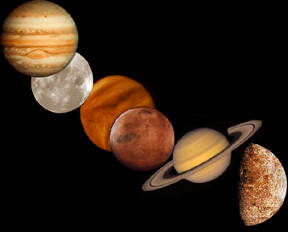The picture above is a false-color image of loops of hot, electrified gas on the rim of the
Sun, taken with the SOHO spacecraft.
Click on image for full size
Image courtesy of SOHO/EIT (ESA & NASA
News Flash from the Sun! Shaking Loops Cause Solar Flares
News story originally written on July 12, 2002
Even though they are far away, solar storms can affect us. They can bother our spacecraft and electrical power systems. So, it is important to NASA and other space organizations to find out how they happen and how we can predict them.
Scientists have been looking at huge loops of very hot gas that rise above the sunís surface. They found that these loops shake during solar storms. The shaking may help explain why the loops become solar flares during storms.
The loops look like huge arches on the sun. They are very large and very hot and they have a strong magnetic field that keeps the loop stretched tight.
Scientists have seen loops before, but they have never seen any like this! These loops shake back and forth very slowly every 20 minutes. The shaking may come from bursts of very energetic particles from low in the Sunís atmosphere. If these bursts of particles are very strong, they may change the loop into a solar flare!
Last modified July 18, 2002 by Lisa Gardiner.
You might also be interested in:

It was another exciting and frustrating year for the space science program. It seemed that every step forward led to one backwards. Either way, NASA led the way to a great century of discovery. Unfortunately,
...more
The Space Shuttle Discovery lifted off from Kennedy Space Center on October 29th at 2:19 p.m. EST. The sky was clear and the weather was great. This was the America's 123rd manned space mission. A huge
...more
Scientists found a satellite orbiting the asteroid, Eugenia. This is the second one ever! A special telescope allows scientists to look through Earth's atmosphere. The first satellite found was Dactyl.
...more
The United States wants Russia to put the service module in orbit! The module is part of the International Space Station. It was supposed to be in space over 2 years ago. Russia just sent supplies to the
...more
A coronal mass ejection (CME) happened on the Sun last month. The material that was thrown out from this explosion passed the ACE spacecraft. ACE measured some exciting things as the CME material passed
...more
Trees and plants are a very important part of this Earth. Trees and plants are nature's air conditioning because they help keep our Earth cool. On a summer day, walking bare-foot on the sidewalk burns,
...more
There is something special happening in the night sky. Through mid-May, you will be able to see five planets at the same time! This doesn't happen very often, so you won't want to miss this. Use the links
...more















